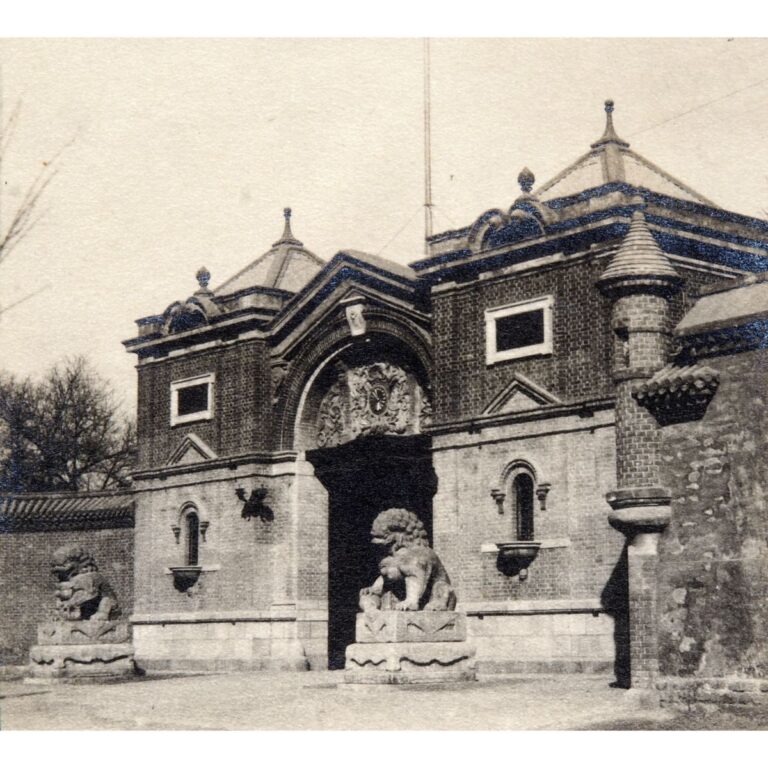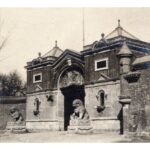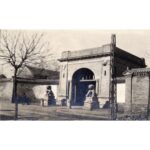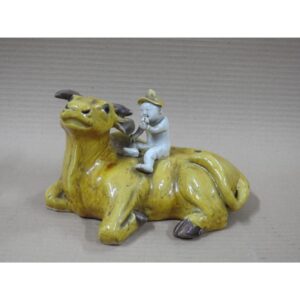Photography The Official Entrance to the Japanese Legation
A black-and-white photograph showing the main entrance of the Japanese embassy or legation in the diplomatic quarter in Beijing (Dongjiaominxiang 東交民巷). Between 1861 and 1959, the latter was established in the area of the Inner City (Neicheng 内城), east of present-day Tiananmen Square (Tiananmen Guangchang 天安門廣場), and south of the Forbidden City (Gugong 故宫 or Zijincheng 紫禁城). The territories of each legation were surrounded by a wall. In the legations, foreign powers built various infrastructures – from churches, hospitals, barracks, post offices and schools to banks and hippodromes. Access to the legation was possible at certain points through a designated portal and a guardhouse, above which the national flag was hoisted.
A pair of shishi 石獅 lion guards stands in front of the entrance. Statues in the shape of a mythological half-lion, half-dog are placed on one side of the entrance as guards of the legation. The motif of lion guardians is ... more
A black-and-white photograph showing the main entrance of the Japanese embassy or legation in the diplomatic quarter in Beijing (Dongjiaominxiang 東交民巷). Between 1861 and 1959, the latter was established in the area of the Inner City (Neicheng 内城), east of present-day Tiananmen Square (Tiananmen Guangchang 天安門廣場), and south of the Forbidden City (Gugong 故宫 or Zijincheng 紫禁城). The territories of each legation were surrounded by a wall. In the legations, foreign powers built various infrastructures – from churches, hospitals, barracks, post offices and schools to banks and hippodromes. Access to the legation was possible at certain points through a designated portal and a guardhouse, above which the national flag was hoisted.
A pair of shishi 石獅 lion guards stands in front of the entrance. Statues in the shape of a mythological half-lion, half-dog are placed on one side of the entrance as guards of the legation. The motif of lion guardians is a popular one in Chinese Buddhism. It probably evolved from the depiction of dogs as protectors of the Dharma in India. Stylised lions stood at the entrances of tombs, palaces, and government buildings in China and other Buddhist sites in Asia. The oldest statues in China date back to the 3rd century B.C. They are said to protect against harmful spirits and human actions. The male often has a ball under his paw, the female a lion cub.
After the Second Opium War (1856-1860), several foreign delegations settled in the diplomatic quarter and established legations of their countries. The city attracted many diplomats, soldiers, scholars, artists, tourists, and Sinophiles.
Although international agreements granting foreign powers extraterritorial rights over parts of its territory date back to the 19th century, jurisdiction over Beijing’s diplomatic quarter itself was not granted to foreign countries until 1901, following a 55-day siege of the quarter during the two-year Boxer Rebellion (Yuanyituan Yundong 義和團運動), which ended with the victory of the combined foreign forces. Because of the cooperation of the Chinese court with the insurgents, China was forced to sign the Boxer Protocol (Xinchou Tiaoyue 辛丑條約), which also established the administration of the diplomatic quarter in Beijing.
By the beginning of the 20th century, all the major countries of the world were represented here, including the Netherlands, the United Kingdom, France, Germany, Japan, Russia, Italy, Spain, Belgium, and the United States. A smaller plot of land was also owned by the Austro-Hungarian Empire.
The photograph is the 53rd of 449 photographs of Beijing and its surroundings in the album of Ivan Skušek Jr., purchased during his stay in Beijing (1914–1920). In the handwritten inventory of the album, the photograph is referred to as Tor der japanischen Legation. (DZ, MV)





































Do you have a comment or additional information about the subject?